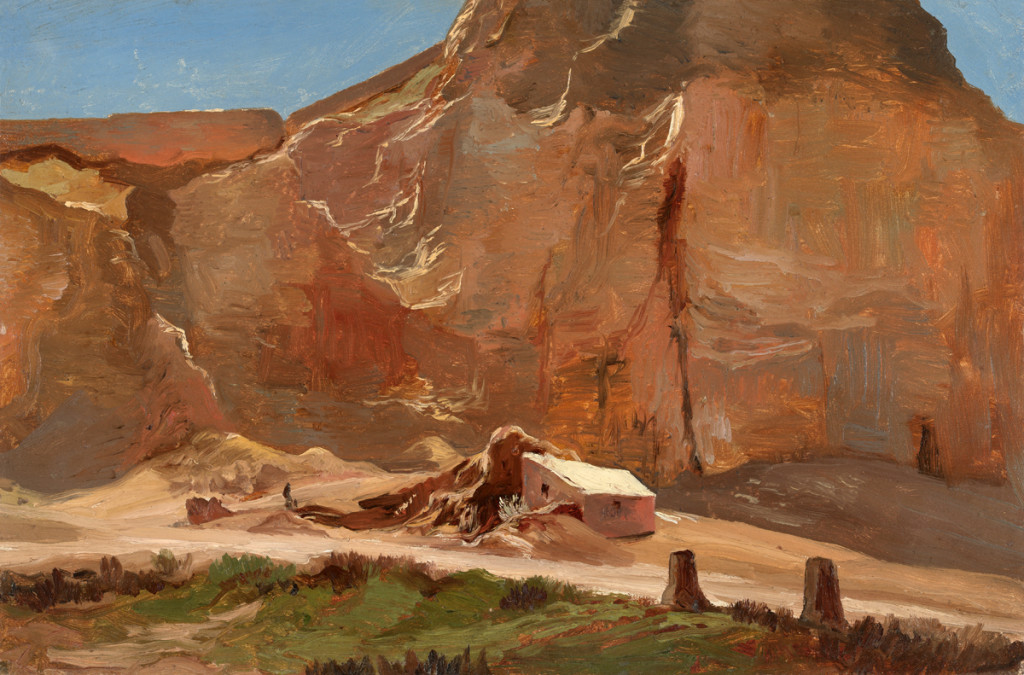Charles-François Eustache (Paris 1820 - 1870 Cherbourg)
Landscape in the Orient, 1840s
Oil on paper, laid down on canvas, 28 x 42.4 cm
On the verso the stamp of the studio sale vente d'atelier Ch. Eustache
Provenance:
Charles-François Eustache studio sale
Charles-François Eustache was financially independent, so his artistic career was unaffected by considerations of having to cater to contemporary collecting taste. He exhibited at the Paris Salon in 1849, 1850 and 1852. After his untimely death in 1870 his work disappeared from public view and was overlooked for over a century until a Paris art gallery began to show it in the 1970s.
Eustache was born in Paris in 1820. He began his training under Prosper Marilhat (1811-47), a Paris-based landscape painter and Orientalist. Eustache was invited by Marilhat to join him on a trip to the Near East.[1] Eustache came into contact with the painters Charles Desprez (1818- after 1852) and Eugène Fromentin (1820-76) who shared his enthusiasm for travel. The three friends visited Egypt and Nubia both in 1842 and in 1847. Eustache also visited Italy, Corsica, Provence, Switzerland and Great Britain. It was Desprez who probably introduced him to Alexandre Calame on a visit to Geneva. He developed a strong admiration for Calame's work.
Eustache was a particularly inventive artist. He produced a large body of cloud studies, very probably prompted by his observation of cloud formations on his travels in England and Scotland. In 1851 he began to focus on motifs drawn from his study of an iron works and foundry owned by the family of his late wife in Fourchambault in central France.
However, the landscapes of what used to be termed the Orient and, in particular, the landscapes of Egypt were undoubtedly his chief interest throughout his artistic career.[2] When his health began to fail in 1857 and he was no longer able to travel he settled in Cherbourg and continued to paint Near Eastern motifs in his studio. He worked from memory, basing many of his paintings on the oil sketches he had made on his travels.[3]
This oil study was almost certainly executed in Egypt, possibly in the Sinai or in the neighbourhood of the Nile.[4] Eustache focuses his attention on the powerful tonal contrasts between the pinkish-reds and browns of the iron-bearing rock strata and the greenness of the grass. His layered execution of light effects in successive zones is a good example of his original approach to the handling of space.[5] The details of the rock strata are delicately modelled in short, cursory brushstrokes and are set against the clear blue of the sky. A small hut tucked into the rocky terrain at the foot of the cliff in the middle ground provides a diminutive staffage element.
[1] For details of Eustache's biography, see Patrice Marandel, 'Pour Charles-François Eustache (1820-1870)', in L'Œil, 267, Paris 1977, pp. 28-33. [2] In Eustache's day the term 'Orient' was used when referring to North Africa and the Middle East. Napoleon's Egyptian campaign of 1798-1801 was largely responsible for encouraging artistic interest in Egypt and its antiquities. Jean-Léon Gérôme (1824-1904), almost certainly the best-known French nineteenth-century Orientalist, travelled to the Near and Middle East on at least twelve occasions. See Jennifer Meagher, 'Orientalism in Nineteenth-Century Art', in Heilbrunn Timeline of Art History, New York 2000: <http://www.metmuseum.org/toah/hd/euor/hd_euor.htm>, (accessed 25.09.2014). [3] In 1857, Eustache also began to develop an interest in local motifs in the Cherbourg area. He produced views of Normany in oil, pastels and charcoal. [4] A number of Eustache's letters to his mother and to Desprez are preserved but his personal diary and travel diaries are now lost. See Marandel, op. cit. p. 28. [5] See Gérald Schurr and Pierre Cabanne, Dictionnaire des Petits Maistres de la peinture 1820-1920, I, Paris 1996, pp. 411-2.

